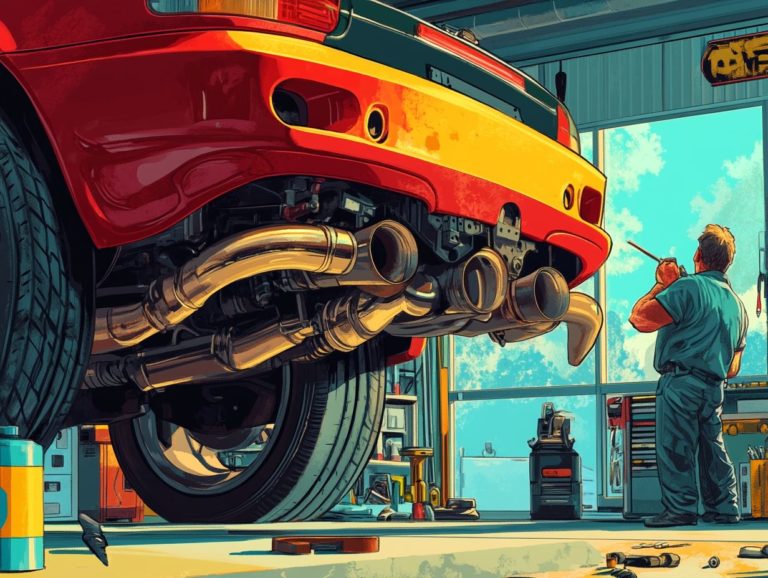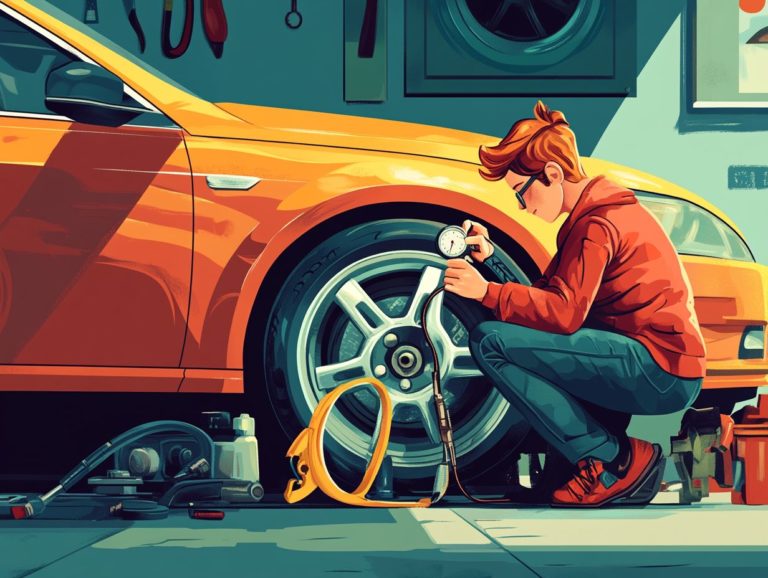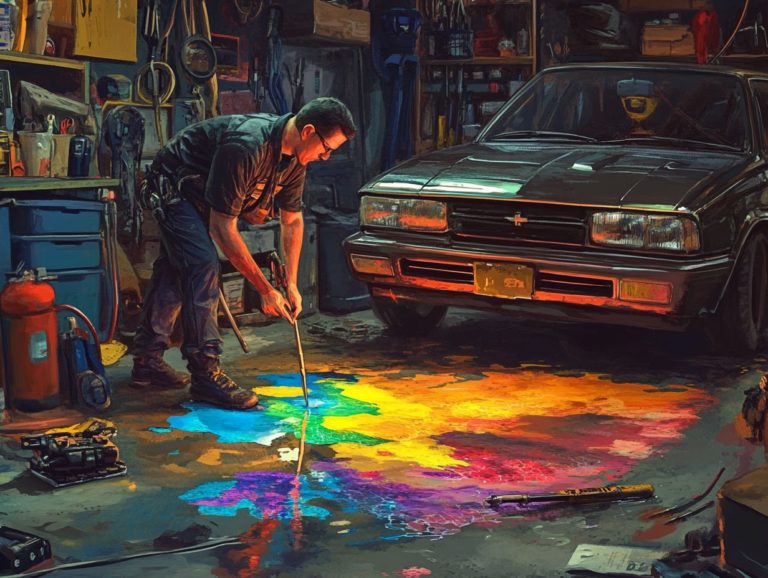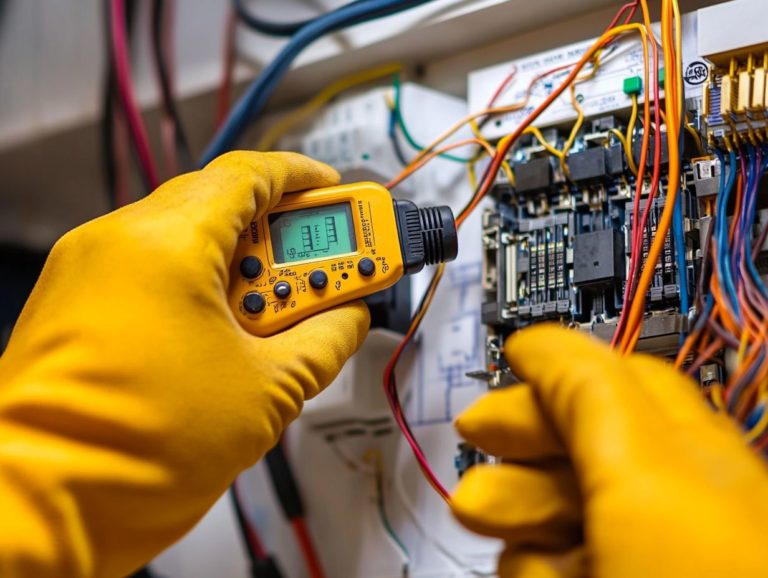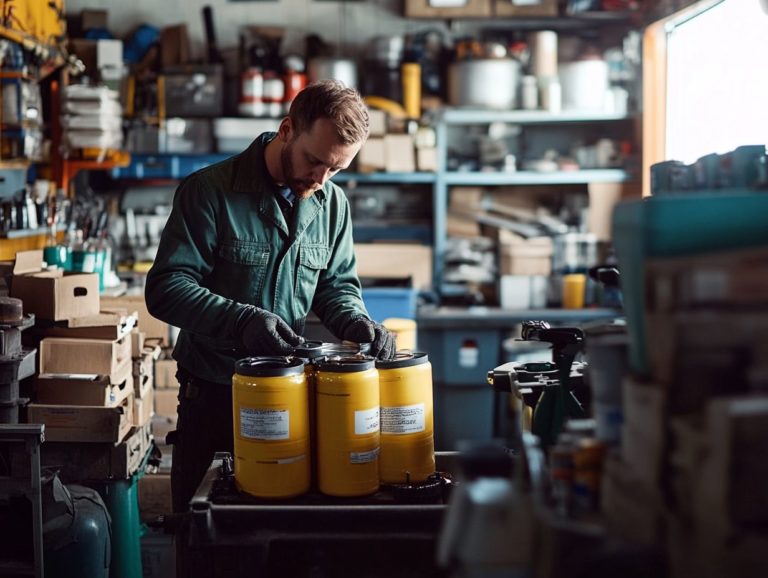How to Spot Signs of Rust on Your Car?
Rust on your car can be more than just an unsightly blemish; it can escalate into serious safety and financial concerns if left unattended.
Understanding rust and how it forms is essential for every car owner. This guide will walk you through identifying rust indicators, recognizing warning signs, and implementing effective maintenance strategies to prevent it.
You ll also discover DIY rust removal methods, professional solutions, and the potential consequences of ignoring this pressing issue.
By arming yourself with this knowledge, you can ensure your vehicle remains in prime condition and effectively combat rust!
Contents
Key Takeaways:

- Regularly inspect your car for rust indicators like bubbling paint.
- Watch for signs such as strange noises that may signal larger rust issues.
- Maintain and clean your car regularly to prevent rust and preserve its value.
Understanding Rust on Cars
Understanding rust on cars is vital for anyone considering the purchase of a used vehicle. Rust-related problems can lead to serious consequences, including compromised safety and diminished resale value.
Rust, a form of corrosion, arises when metal is exposed to moisture and oxygen. Several factors, such as geographical location, humidity, and salt, can worsen rust conditions. In areas like Ohio and the Northeast, where road salt is frequently used, the risk of encountering rust issues significantly escalates.
Potential buyers must evaluate the vehicle’s history and condition carefully before making a decision.
What is Rust and How Does it Form?
Rust emerges from a corrosion process that occurs when iron or steel encounters moisture, oxygen, and various environmental factors, including humidity and salt.
In this intricate chemical reaction, water facilitates electron transfer between iron and oxygen, ultimately leading to iron oxides. When salt, especially sodium chloride, is involved, it dramatically speeds up the process by enhancing the conductivity of the water, increasing the reaction rate.
High humidity levels create perfect conditions for rust to thrive, as moisture in the air condenses on metal surfaces, fueling these electrochemical reactions. This makes coastal regions particularly vulnerable, where salty breezes accelerate corrosion.
Signs of Rust on Your Car
Recognizing the signs of rust on your car is crucial for maintaining its value and ensuring your safety, especially when evaluating a used vehicle. Look for common visual indicators such as paint bubbling, rust spots, and exposed metal areas from corrosion.
A thorough inspection by a mechanic can uncover any hidden rust issues, allowing you to address repairs promptly and preserve your car’s integrity.
Visual Indicators of Rust
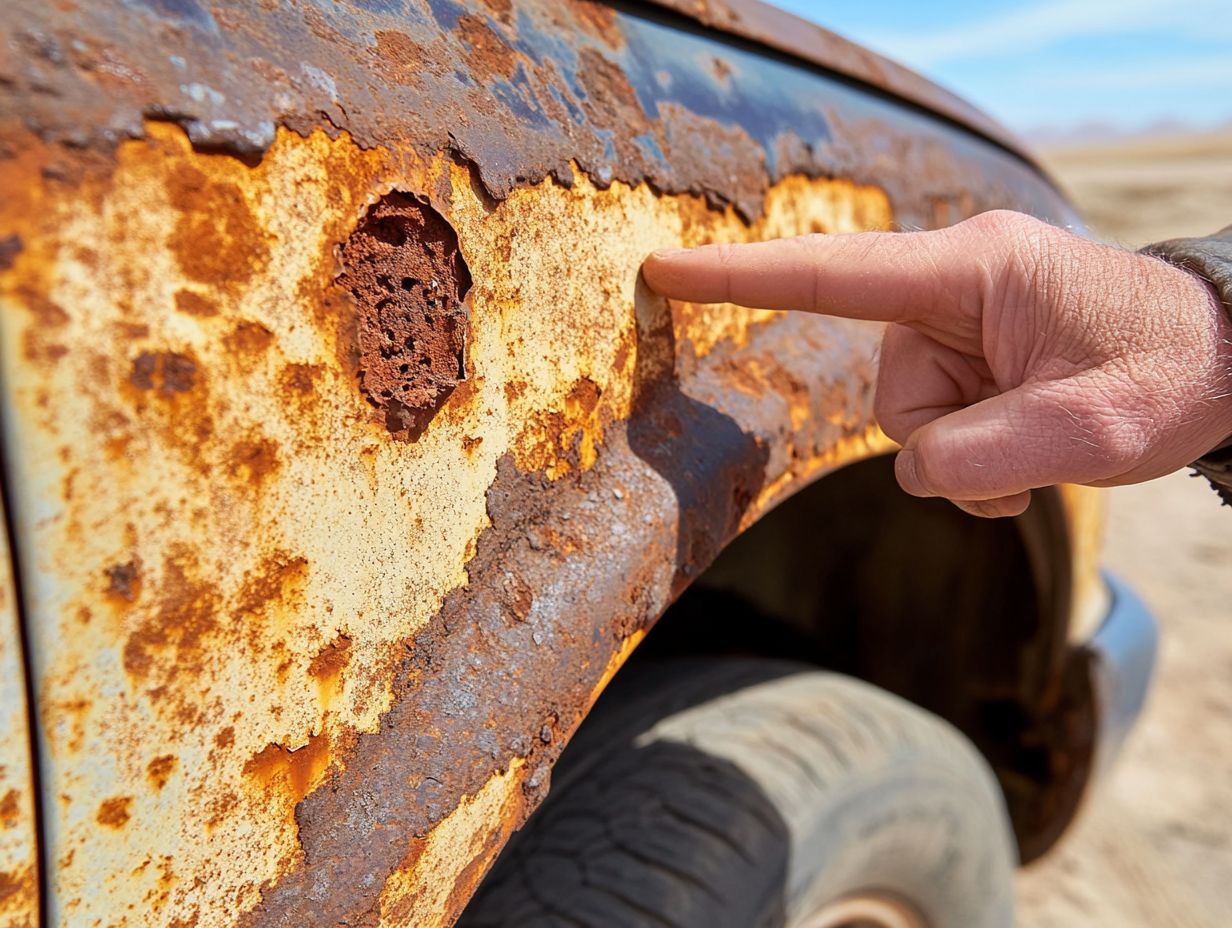
Visual indicators of rust can appear in various ways, with surface rust, paint bubbling, and rust spots being the most common signs. Each of these indicates potential deterioration of your vehicle’s structure.
Surface rust typically appears as a fine, powdery layer that can be scraped away easily. However, neglecting this seemingly minor issue can lead to more severe corrosion beneath the paint. Conversely, paint bubbling is a clear sign that moisture is trapped underneath the top coat, which indicates a breakdown of that crucial protective layer. Distinct rust spots, usually brown or reddish, reveal deeper oxidation and require immediate attention.
Recognizing these visual cues early can help you preserve your car’s value and protect yourself from costly repairs down the line.
Don’t miss this chance to protect your investment! Check your vehicle for rust today!
Other Warning Signs
Plus visual cues, keep an eye out for other warning signs like unusual noises or changes in how the vehicle performs; these could indicate underlying rust issues. Getting a mechanic to take a look is essential when considering a used car.
If the vehicle struggles to accelerate or shows strange vibrations while driving, it might suggest that crucial components are suffering from corrosion. If the brakes feel less responsive or emit grinding sounds, hidden rust on the brake lines could be the culprit, posing a serious safety risk.
Ignoring these signs can lead to costly repairs and put the safety of both the occupants and other road users at risk. A quick chat with a professional can help you catch any rust issues before they escalate!
They can recommend necessary rust repairs to ensure you enjoy a reliable and safe driving experience.
Preventing Rust on Your Car
Preventing rust on your car transcends mere visual inspections; it requires proactive measures to ensure longevity, especially in humid and salty environments.
Opting for rust-proofing is an exceptionally effective strategy to protect your vehicle from corrosion. When paired with regular maintenance, you can significantly diminish the risk of rust development.
Simple yet impactful practices, such as washing your car regularly to eliminate salt and debris, help maintain its optimal condition.
Effective Maintenance Tips
Implementing effective maintenance tips can significantly aid in rust-proofing your vehicle from the damaging effects of corrosion.
By taking a proactive approach to maintenance, you can ensure the longevity of your car while safeguarding it against the persistent threat of rust. Regularly washing your vehicle, especially during the winter months when road salt is a common adversary, helps eliminate corrosive substances that tend to cling to metal surfaces.
Applying a high-quality wax creates a protective barrier, keeping moisture at bay. Inspect all seals and weatherstrips for wear and replace them promptly, as these areas can serve as gateways for water, potentially leading to rust formation.
Considering a professional undercoating a protective layer applied to the underside of your car can provide an extra layer of protection, shielding the undercarriage from harsh elements and ultimately prolonging your vehicle s lifespan.
Removing Rust from Your Car
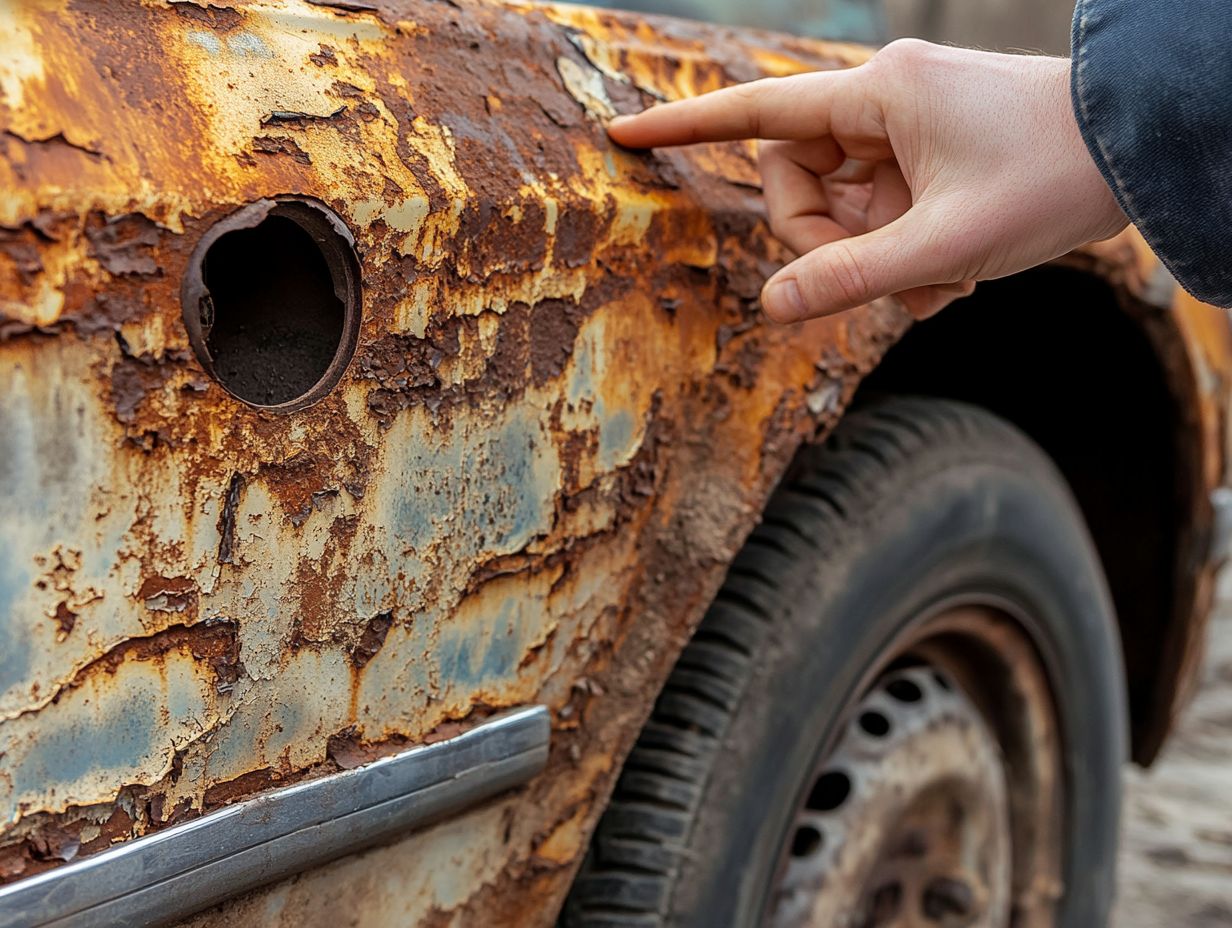
Removing rust from your car may feel overwhelming, but it s manageable with the right approach be it DIY methods or professional interventions.
Regular check-ups with a mechanic are invaluable; they help identify rust early on, enabling timely repairs before the issue escalates.
Whether you decide to take on rust removal yourself or enlist the help of a professional, grasping the essential steps and techniques is vital for restoring your vehicle’s integrity and keeping it in prime condition.
DIY Methods and Professional Solutions
DIY methods for rust removal can work wonders on minor rust spots, but for more extensive repairs, professional solutions are often the way to go.
For smaller projects, you might find success using techniques like baking soda paste, vinegar, or commercial rust removers. These can be easily applied with brushes or cloths, making the process straightforward. To speed things up, tools such as sandpaper, wire brushes, and even power tools like angle grinders can be invaluable.
If you encounter significant rust damage think pitted metal or structural rust on vehicles or machinery it s wise to seek professional help. Experts in the field have specialized equipment and the know-how to deliver a thorough and lasting restoration, ensuring your items are protected from further deterioration.
Consequences of Ignoring Rust on Your Car
Neglecting rust on your car can have serious repercussions, significantly impacting both safety and resale value, particularly when it comes to selling a used vehicle.
Rust doesn t just threaten the structural integrity of your car; it also creates potential hazards that could jeopardize the well-being of both the driver and passengers. The longer you allow rust issues to fester, the more extensive and costly the repairs will become, ultimately diminishing your vehicle s market appeal.
Keep your car in top shape your safety depends on it!
Impact on Safety and Resale Value
Ignoring rust can seriously threaten your safety and lower the resale value of your used car.
Rust can damage critical parts like the suspension system, which supports your car and keeps it stable. This puts everyone inside and on the road at risk.
The exhaust system isn t spared either; extensive rust can lead to leaks, allowing toxic fumes to infiltrate the cabin and create a dangerous driving environment.
Visible rust can turn potential buyers away, dropping your car’s resale value. Timely rust management not only extends your vehicle’s life but also preserves its market worth.
Frequently Asked Questions
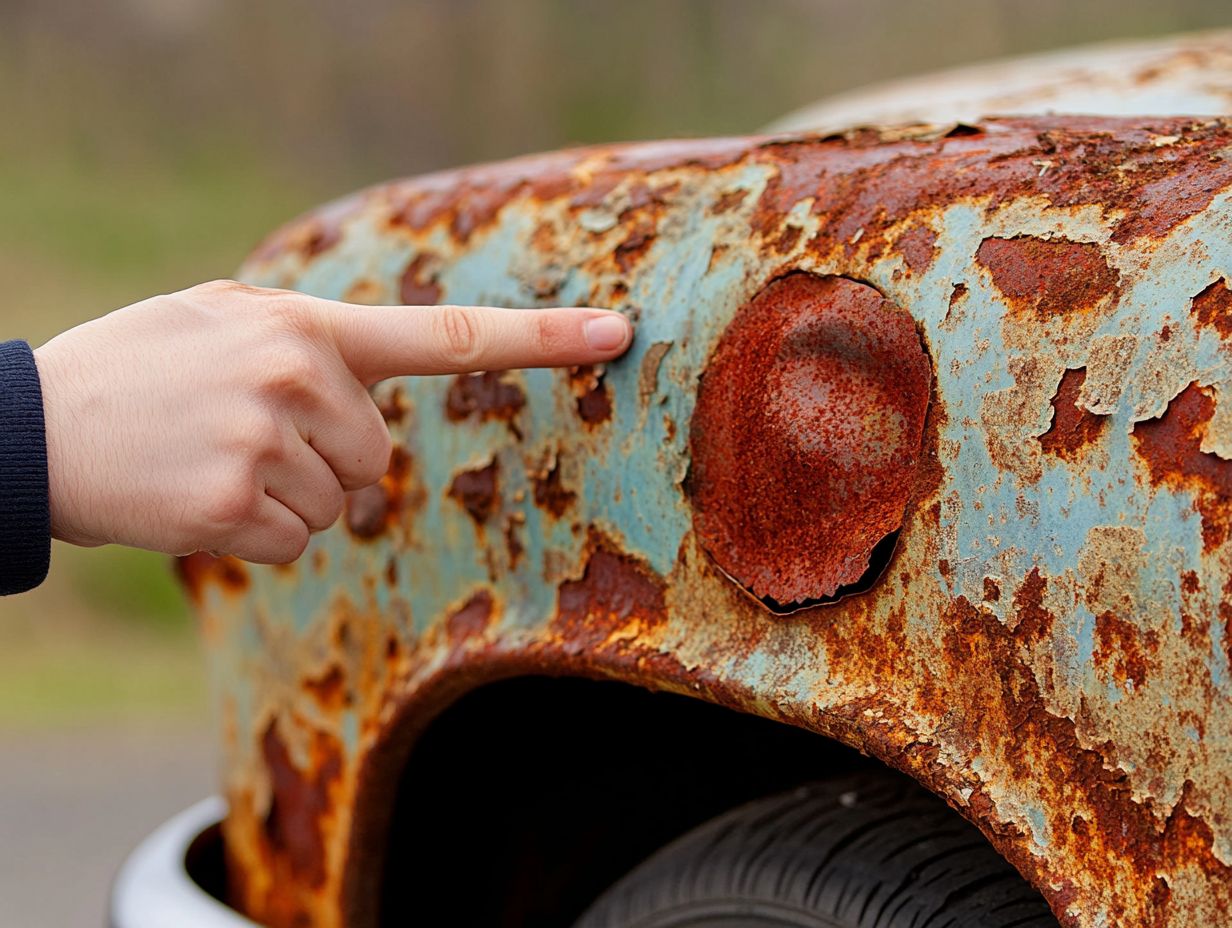
Spotting Rust: What to Look For
Some common signs of rust on a car include:
- Flaking or bubbling paint
- Visible red or brown spots
- Rust-colored dust on the exterior
Where to Check for Rust on Your Car
Rust can appear on any metal surface of your car, but it is most commonly found on:
- The undercarriage
- Wheel wells
- Edges of doors and windows
Preventing Rust on Your Car
To prevent rust, regularly wash your car, especially in areas with salt or other corrosive materials on the roads. Applying a protective wax or coating can also help.
What to Do If You Find Rust
If you spot rust, don t delay! Address it as soon as you spot it to keep your car in top shape. You can try using a rust remover or sanding the affected area, but if the rust has spread too far, it may require professional repair.
Does Rust Affect Performance?
Yes, rust can weaken your car’s structural integrity and potentially cause serious damage if left untreated. It may also impact the functioning of critical parts like brakes and suspension systems.
Understanding Surface Rust vs. Structural Rust
Yes, surface rust is limited to the outermost layer of paint and can be easily removed. Structural rust, however, penetrates deeper into the metal and can cause significant damage to your car’s structure and safety.

